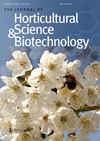树莓年生长周期的控制
IF 2.1
4区 农林科学
Q2 HORTICULTURE
Journal of Horticultural Science & Biotechnology
Pub Date : 2000-01-01
DOI:10.1080/14620316.2000.11511294
引用次数: 22
摘要
引种处理(渗透调节)能显著提高种子萌发性能,被种子公司广泛应用于提高商品蔬菜和花卉种子成苗率和成苗均匀性。通过测量显示4C DNA含量的细胞核百分比的增加,已经观察到辣椒(Capsicum annuum L.)种子经过渗透调节后,胚胎根尖细胞进入细胞周期的S期和G2期。在这里,我们报道了渗透调节效应与DNA复制的激活以及微管的组成元素p-微管蛋白(p-tubulin)在PEG 6000溶液中启动时在胚胎根尖上的积累之间的关系,渗透电位为-1.1和-1.5 MPa。在干燥种子中,流式细胞术显示大多数细胞停留在细胞周期的Gi期,而在western blots上未检测到β-微管蛋白。在启动过程中,β-微管蛋白似乎是从头合成的,其积累先于DNA复制。在每个启动条件下,DNA复制和对微管蛋白积累的时间进程和数量与种子萌发性能的提高有关。讨论了它们作为区分先验启动有效性的分子标记的潜在用途。本文章由计算机程序翻译,如有差异,请以英文原文为准。
The control of the annual growth cycle in raspberry
Summary Priming treatments (osmoconditioning), which can considerably improve seed germination performance, are widely applied by seed companies to increase the rate and uniformity of seedling establishment of commercial vegetable and flower seeds. Advancement of embryonic root tip cells into S and G2 phases of the cell cycle, as measured by the increase in the percentage of nuclei showing a 4C DNA content, has been observed to occur after osmoconditioning of pepper (Capsicum annuum L.) seeds. Here we report the relationship between osmoconditioning effects and the activation of DNA replication as well as the accumulation of p-tubulin, a constitutive element of microtubules, in the embryo root tips during priming in PEG 6000 solutions, at the osmotic potentials of ‒1.1 and ‒1.5 MPa. With dry seeds, flow cytometric profiles indicated that most of the cells were arrested at Gi phase of the cell cycle while β-tubulin was not detectable on western blots. During priming, β-tubulin appeared to be synthesized de novo and its accumulation preceded DNA replication. Within each priming condition, the time courses and amounts of DNA replication and p-tubulin accumulation were found to correlate with improved seed germination performance. Their potential use as molecular markers for discriminating a priori priming effectiveness is discussed.
求助全文
通过发布文献求助,成功后即可免费获取论文全文。
去求助
来源期刊
CiteScore
3.90
自引率
5.30%
发文量
67
审稿时长
3 months
期刊介绍:
The Journal of Horticultural Science and Biotechnology is an international, peer-reviewed journal, which publishes original research contributions into the production, improvement and utilisation of horticultural crops. It aims to provide scientific knowledge of interest to those engaged in scientific research and the practice of horticulture. The scope of the journal includes studies on fruit and other perennial crops, vegetables and ornamentals grown in temperate or tropical regions and their use in commercial, amenity or urban horticulture. Papers, including reviews, that give new insights into plant and crop growth, yield, quality and response to the environment, are welcome, including those arising from technological innovation and developments in crop genome sequencing and other biotechnological advances.

 求助内容:
求助内容: 应助结果提醒方式:
应助结果提醒方式:


